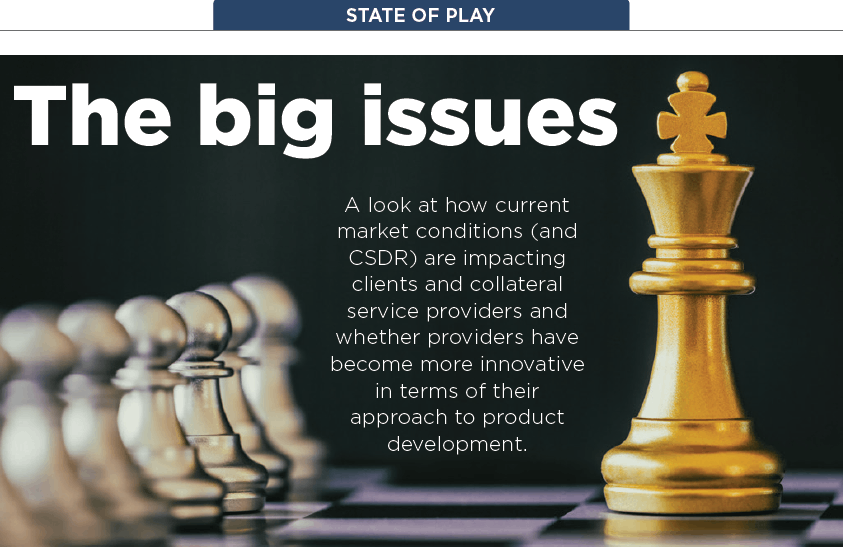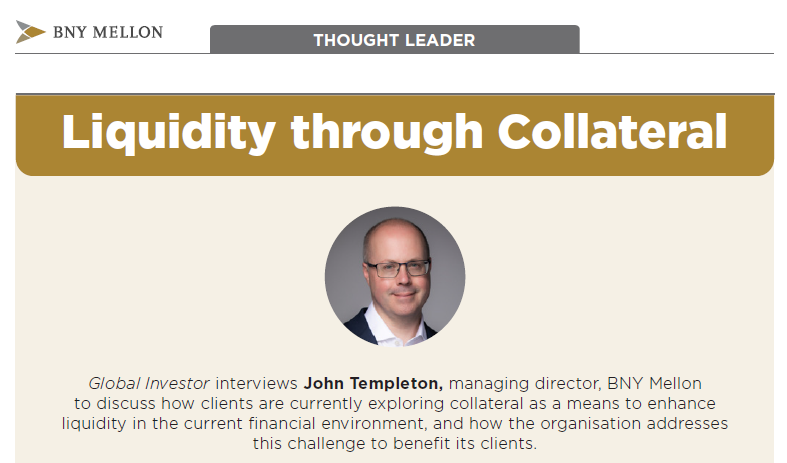Collateral Guide 2023 - State of Play: The Big Issues

State of Play: The big issues
A look at how current market conditions (and CSDR) are impacting clients and collateral service providers and whether providers have become more innovative in terms of their approach to product development.
This Thought Leadership article is part of the 2023 Collateral Management Guide, which can be accessed here.
In August, the European Central Bank published an opinion as part of the ongoing review of the European Commission’s proposal to amend the Central Securities Depositories Regulation (CSDR).
The ECB advised that the entire application of the mandatory buy-in regime should be removed, stating that it would cause ‘a significant interference in the execution of securities transactions and the functioning of securities markets’ and also highlighting the non-availability of a buy-in agent in the market.
The ECB also suggested excluding securities finance transactions from the scope of mandatory buy-ins were they to come into effect.
The previous month, ISLA CEO, Andrew Dyson, described CSDR as something of a wakeup call for the industry, noting that fail rates remain persistently high and if recent data is to be believed, marginally worse than this time last year.
“If we fail to grasp the nettle this time, I fear that our industry will become less relevant and increasingly confined to the margins of the capital markets ecosystem, as other products offer similar economic outcomes with less operational friction,” he said.
Another major challenge facing market participants is collateral rarefaction suggests Jérôme Blais, co-head of triparty collateral management, securities services at BNP Paribas.
“As a collateral provider, we have to be proactive when supporting clients who may be short on liquidity and assist them in their collateral relationships across counterparties,” he says.
Allowing clients to fine tune collateral eligibility criteria has also become critical. By building user friendly and reactive tools with pre-trade simulation features, collateral service providers can help clients pilot their funding needs more accurately.
Collateral departments are also dealing with the squeeze on cash collateral driven by inflation and rising interest rates.
“Cash may no longer always be cost effective, so firms must look at non-cash collateral and increasingly at equities,” says Trevor Negus, senior product manager SmartStream. “We have seen requests for eligibility schedules and concentration rules adjusted to allow for equity collateral.”
Firms must also look at their ESG credentials and eligibility schedules are being further tailored to accommodate ESG (see sidebar).
“CSDR has put pressure on firms to connect their collateral and settlement systems through APIs, allowing programmatic flow of booked collateral out, and settlement and fail information back,” adds Negus. “Operating on a batch basis is no longer sufficient.”
According to Bimal Kadikar, founder and CEO Transcend, current market conditions are a major factor in the focus on the intersection of collateral, liquidity and funding across the globe, particularly in North America and Europe.
"Increased volatility has resulted in sizeable margin requirements and the rising interest rate environment means the cost of making these decisions has become more significant, so any opportunity to optimise will have a notable effect on return on investment,” he says.
Clients are looking for solutions that offer increased automation and visibility. “From our perspective, the ability to coordinate across collateralised business areas is a major focus for clients,” adds Kadikar. “There is a lot of innovation taking place in terms of bringing together different elements around equity finance, repo, OTC derivatives, cleared derivatives, and functions relating to operations and treasury.”
Industry players have acknowledged that there needs to be a higher level of internal and external connectivity adds BJ Marcoullier, head of sales at Transcend.
“There is a lot of evaluation taking place around service provider versus principal activity – once the systems and data have been organised, who should be doing what to make sure the best decision making is sitting in the smartest locations,” he says.
Neil Murphy, business manager triResolve at OSTTRA notes that collateral managers continue to be sensitive to the next period of market volatility. For many, this manifests itself in ensuring a state of readiness so that they are able to cope with increased call volumes and a potential spike in collateral funding needs.
In order to prepare, firms are looking to increase use of market standards, thus ensuring more potential for STP and an ability to cope with larger volumes.
“Technology innovation should be at the forefront for both providers and collateral managers,” says Murphy. “The ability to cope with increased volumes and ongoing regulatory change - while removing legacy manual processes - provides a common thread.”
Innovation can take many forms, but is increasingly about connectivity to counterparties, custodians, and a disparate range of systems.
“For providers, this often means working collaboratively to ensure interoperability across platforms, thus helping clients to reduce complex IT connectivity and moving away from product silos,” adds Murphy.
Tri-party agents play a key role in the operating and practical side of posting collateral and agents must evolve in tandem with their clients, regulations and the financial markets according to Sagar Patel, head of Americas tri-party product at J.P. Morgan.
“Broadly, there is simply more integration and connectivity with tri-party agents than ever, whether it is with clients’ systems or with third party service providers that they have hired,” he explains. “For example, digitising collateral eligibility schedules and feeding that data to our clients’ systems or third party vendors has been a common theme, as firms want a holistic view of their eligibility criteria to run over their own analytical processes.”
There has been a lot of investment and time spent on these types of enhancements and Patel sees this as an ongoing theme.
“In general, the collateral network will expand and there will continue to be more connectivity across organisations,” he says. “There are vendor solutions out there that can help, connecting both internal and external systems, taking data directly from the client or their service providers and consolidating it, providing a real time view of collateral.”
In many cases, clients can directly instruct the vendor as to what they require downstream.
To efficiently move collateral for optimal treatment, whether bilateral or tri-party, is a natural next step once a firm has a consolidated view. The integration of third parties, tri-party agents and other market infrastructure is key to efficiently moving collateral from one place to another in an automated way and in a timely fashion.
“The benefit of using third parties is that they maintain the connectivity across all those systems and sources, taking the component of build and maintenance off the client’s plate and allowing them to focus on the bigger picture,” says Patel.
There also has been much innovation in terms of collateral mobility of hard to finance assets. Hard to finance assets have value but are challenged in terms of financing - for example, the challenge could be scarcity of reference data and pricing, the security may be strictly controlled, or not held at a traditional depositary. Examples of such assets include private issuances and restricted shares. “The programme of restricted shares referenced above are not held at a traditional depository (such as DTC) but rather at a transfer agent,” explains Patel. “The shares are difficult to mobilise and utilise in a traditional financing and tri-party transaction due to the location and lack of connectivity to financing platforms.”
To free and mobilise these types of assets, agents such as J.P. Morgan have developed a framework and process flow to support accessibility within the tri-party programme. The primary challenge to mobilise these types of assets is receiving and delivering the securities from and to a transfer agent and reconciliation in an automated fashion.
Innovative operational, legal and technological models are required here for full comfort across an organisation’s front office, operations, and various oversight teams.
The effects of ESG
According to ISLA, the industry is increasingly factoring climate financial risk and other sustainability risk considerations into collateral selection. However, it warns that any new ESG criteria applicable to collateral selection must not result in a collateral set which is too narrow as this could disrupt financial stability and liquidity as well as the ultimate goal of an orderly transition process to a sustainable economy.
It therefore remains vital to ensure adequate diversification of collateral guidelines. Accordingly, the risk analysis for collateral acceptability should continue to take into account all relevant risks, including - but not limited to - sustainability and ESG risks.
The securities lending industry is in a transition phase. Instead of implementing exclusion policies or narrow lists of favoured collateral assets with potentially adverse impacts on risk management and market stability, ISLA considers that appropriate, achievable guidance from regulators and central banks in relation to securities lending and collateral would help to accelerate market participants to the next stage of the path to net zero.
Over the past few years, the financial services industry has witnessed increased interest and focus on ESG conscious investing, especially as firms look to sustainably rebuild and recover in the aftermath of the pandemic.
“Within the securities financing ecosystem, integrating ESG principles into flexible collateral requirements has grown in importance as the pace gathers from asset owners looking to align their eligibility requirements with their funds’ overall ESG objectives,” says Rickie Smith, collateral services product manager J.P. Morgan.
When integrating ESG principles into the selection criteria, asset owners must also consider the importance of ensuring adequate diversification of collateral, especially given the primary role that collateral plays as a credit risk mitigant.
“ESG is highly subjective and due to the lack of standardisation and regulatory clarity it is important that the industry associations (ISLA, PASLA, RMA, GASLA) continue to work together with their member firms in defining recommended best practices and providing support and regulatory advocacy to ensure minimal disruption to the liquidity and smooth running of the underlying markets,” says Smith.
From a J.P. Morgan tri-party perspective, transparency is a key requirement from clients. Within its tri-party programme the bank has introduced a number of ESG indices to support clients looking to align their eligibility parameters to their underlying investor ESG objectives.
“As the demand around transparency continues to accelerate, it is imperative that we increase our menu of supportable indices in addition to exploring potential new solutions that enable customisable, granular and fully automated collateral requirements with underlying reference data which is broadly adopted,” adds Smith.
Found this useful?
Take a complimentary trial of the FOW Marketing Intelligence Platform – the comprehensive source of news and analysis across the buy- and sell- side.
Gain access to:
- A single source of in-depth news, insight and analysis across Asset Management, Securities Finance, Custody, Fund Services and Derivatives
- Our interactive database, optimized to enable you to summarise data and build graphs outlining market activity
- Exclusive whitepapers, supplements and industry analysis curated and published by Futures & Options World
- Breaking news, daily and weekly alerts on the markets most relevant to you




